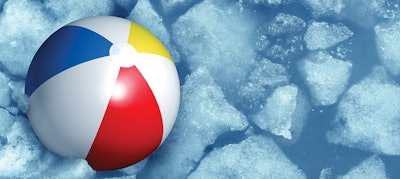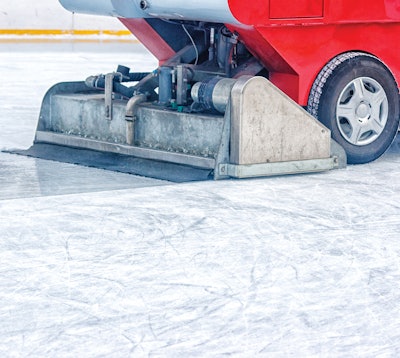
ICE COLD POOL
My precious and I had a wonderful time at the Charles Schulz Museum (Charlie Brown/Peanuts cartoon creator) in Santa Rosa. I especially enjoyed a behind the scenes tour of Snoopy’s Home Ice Skating Rink and thought about how a skating rink is like a swimming pool. For starters, they both contain water, one frozen, one liquid.
A National Hockey League skating rink surface area is 85’ x 200’ (17,000 sq. ft.), but the 20-25 degree ice is only about 3” thick. If pool volume = L x W x D x 7.48 g/ cubic-ft, then an ice rink is about a 32,000-gallon, very shallow, frozen pool.
Over 5 miles of 1” steel welded piping, beneath the ice, circulates about 10,000 gallons of custom-blended, aqueous calcium brine heat transfer fluid coursing through it. The brine pH is 7.5-8.0 and is usually only required to be tested a couple times a year. Absolutely, no air (suction leak?) can get in the solution or the brine becomes highly corrosive. This liquid “hard salt syrup” is pumped from the chillers (un-heat pumps) to the rink. The heat removed from the rink ice is pumped back to heat the arena or buildings. The heat removed is also used, especially, to heat the concrete sub-floor under the ice, to keep the ground from freezing and possibly “popping the frozen pool” out of the ground!
The useful service life of the pumps, chillers, heat exchangers and piping is about 20-30 years. At regular intervals the Zamboni ice-resurfacer shaves about 2,500 lbs of scratched, chipped and dirty ice off the surface, not unlike our pool skimmer netting. Then the Zamboni carefully applies a very even and level 300-500 gallons of fresh warmed “make up water” that freezes solid in minutes.
The ice can’t be too thin or the skates will cut into the painted color team logos and hockey rink markings or worse... below the ice and into the steel pipes. If the ice is too thick, it won’t freeze right and it will like skating in slush.
Although there are a lot of similarities between swimming pools and ice rinks, I have to admit that ice rink care is only slightly similar to routine pool service, and the chemistry is, well, different. On the Langelier Index Water Calculator, I could not find 120,000 ppm calcium (400 times higher than a pool), the extreme total dissolved solids level adjustments (salt content alone is 18 times higher than a pool) or the 27-degree temperature point. And I would absolutely have to test the pH every week. BTW - Charles Shultz wrote 5 cartoon panels a week, plus the Sunday Funnies for 50 years, with no sick route coverage.
 A skating rink is a large (32,000-gallon), thin, frozen pool. A Zamboni ice-resurfacer shaves about 2500 pounds of scratched, chipped and dirty ice off the surface, not unlike our pool skimmer netting.
A skating rink is a large (32,000-gallon), thin, frozen pool. A Zamboni ice-resurfacer shaves about 2500 pounds of scratched, chipped and dirty ice off the surface, not unlike our pool skimmer netting.COLD FEET AND TOES
“The pool’s too cold! It’s freezing!” shrieks the swimmer upon surfacing, after making the first dip cannonball. As many times as we’ve heard that exclamation, it still kinda hurts us pool techs to hear our pool water isn’t “just right.” We strive to be sure the water is not too hot, not too cold, not too wet, not too dry. Oh well, in less than 5 minutes, the same swimmer is happily splashing about and thoroughly enjoying the pool, with no further regard of the temperature, so it must be fine, after all.
Now, the routine daily swimmers can, indeed, feel a degree of water temperature difference from normal, and they will let you know when it’s there. Our modern electronically controlled heater thermostats and sensors are very precise, especially when compared with a cheap floating thermometer or bather skin. The Taylor (no relation to our test kits) digital folding cooking/BBQ thermometer is about $12 at the grocery or hardware store. It provides a mobile, fast and very accurate (+/- 1/10 degree) temperature measure for pools and spas, when needed. Still, even if the pool temperature is exactly at 82.00000 degrees, a highly calibrated Big Toe may claim otherwise.
WINTER EYES
While traveling in recent years, I had a chance to see how northern states, with “seasons,” winterize their pools. The abovegrounders pull the cork and take ‘em apart. The ingrounders drain ‘em down and put a mesh safety cover over the hole. Others have to purge the pipes and pour in antifreeze and maybe float inner tubes or logs in the pool to keep the pool glaciers from cracking the waterline tile. I’m thankful that in California (and likely those IPSSA members in Florida, too) winterizing, to most of us, means just flipping the heater switch off.
This article first appeared in the February 2022 issue of AQUA Magazine — the top resource for retailers, builders and service pros in the pool and spa industry. Subscriptions to the print magazine are free to all industry professionals. Click here to subscribe.











































